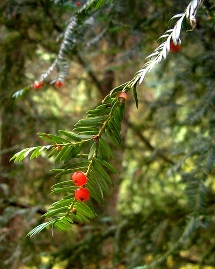Reproduction
Reproduction
by Seed
The Pacific Yew is dioecious, meaning that the male and female
trees are separate. Every once in a while, a Pacific Yew will
have both male and female parts, but that’s very rare. Because
the tree is dioecious, the seeds that are reproduced are forced
to travel to germinate. A good majority of the time, birds are the
dispersers of the seeds. These seeds are produced on the female
tree while the wind-dispersed pollen is produced on the male
tree. By looking at the general life cycle, we can see that
once the seed becomes fertilized, it becomes a sporphyte which
undergoes meiosis to form the megaspores and microspores. These
spores then become megagametophytes and microgametophytes,
respectively. The megagametophtyes produce the egg while the
microspores produce the sperm. Fertilization occurs once again
and the cycle is restarted.
Pacific Yew Seeds
· The fruit ripens from August to October of the same year
that flowering occurred.
· The seeds germinate slowly and require stratification.
· There is some evidence that the seeds can remain dormant
for years in soil and then grow when conditions are favorable.
 Vegetative Regeneration
Vegetative Regeneration
Not only is Taxus brevifolia able to reproduce through
seeds, it’s also able to regenerate by vegetative means. In
fact, in many areas, this is the primary form of reproduction
for the tree. The tree is capable of layering. The layering usually occurs after braches
or the tree tops have been flattened to the ground for quite
some time. These crushed or flatten parts form a series of
layered braches that give rise to many individual organisms.
Also, the branches and stems of the tree frequently root when
they come into contact with the soil and then this will create a
whole other plant as well. When the top of one of these trees is
destroyed, it often sprouts from the stumps or rootstocks as
well.
Now go ahead and take a look at how the Pacific yew interacts with other species on the Interactions page.
